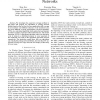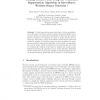229 search results - page 8 / 46 » A Distributed Node Scheduling Protocol Considering Sensing C... |
SENSYS
2003
ACM
14 years 1 months ago
2003
ACM
For many sensor network applications such as military surveillance, it is necessary to provide full sensing coverage to a security-sensitive area while at the same time minimizing...
IJSNET
2006
13 years 7 months ago
2006
: In this paper, we present a two-tiered scheduling approach for effective energy conservation in wireless sensor networks. The effectiveness of this mechanism relies on dynamicall...
ICCCN
2008
IEEE
14 years 2 months ago
2008
IEEE
—We investigate the p-percent coverage problem in this paper and propose two algorithms to prolong network lifetime based on the fact that for some applications full coverage is ...
ISCIS
2004
Springer
14 years 1 months ago
2004
Springer
Considering wireless sensor networks for border surveillance, one of the major concerns is sensing coverage. Breach probability can be used as a measure to analyze the tradeoffs a...
MOBIQUITOUS
2007
IEEE
14 years 2 months ago
2007
IEEE
An important objective of wireless sensor networks (WSNs) is to reliably sense data about the environment in which they are deployed. Reliability in WSNs has been widely studied in...


